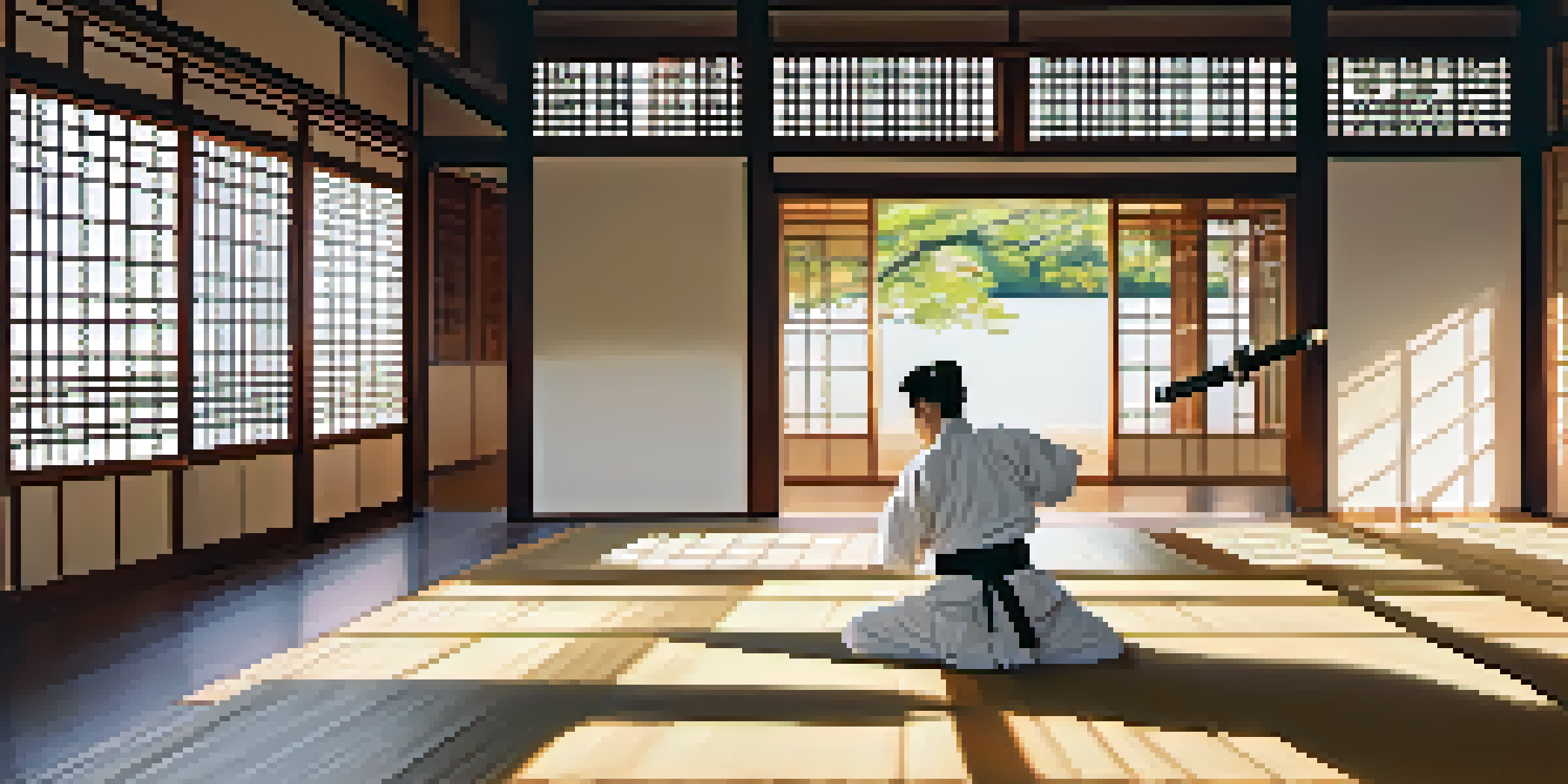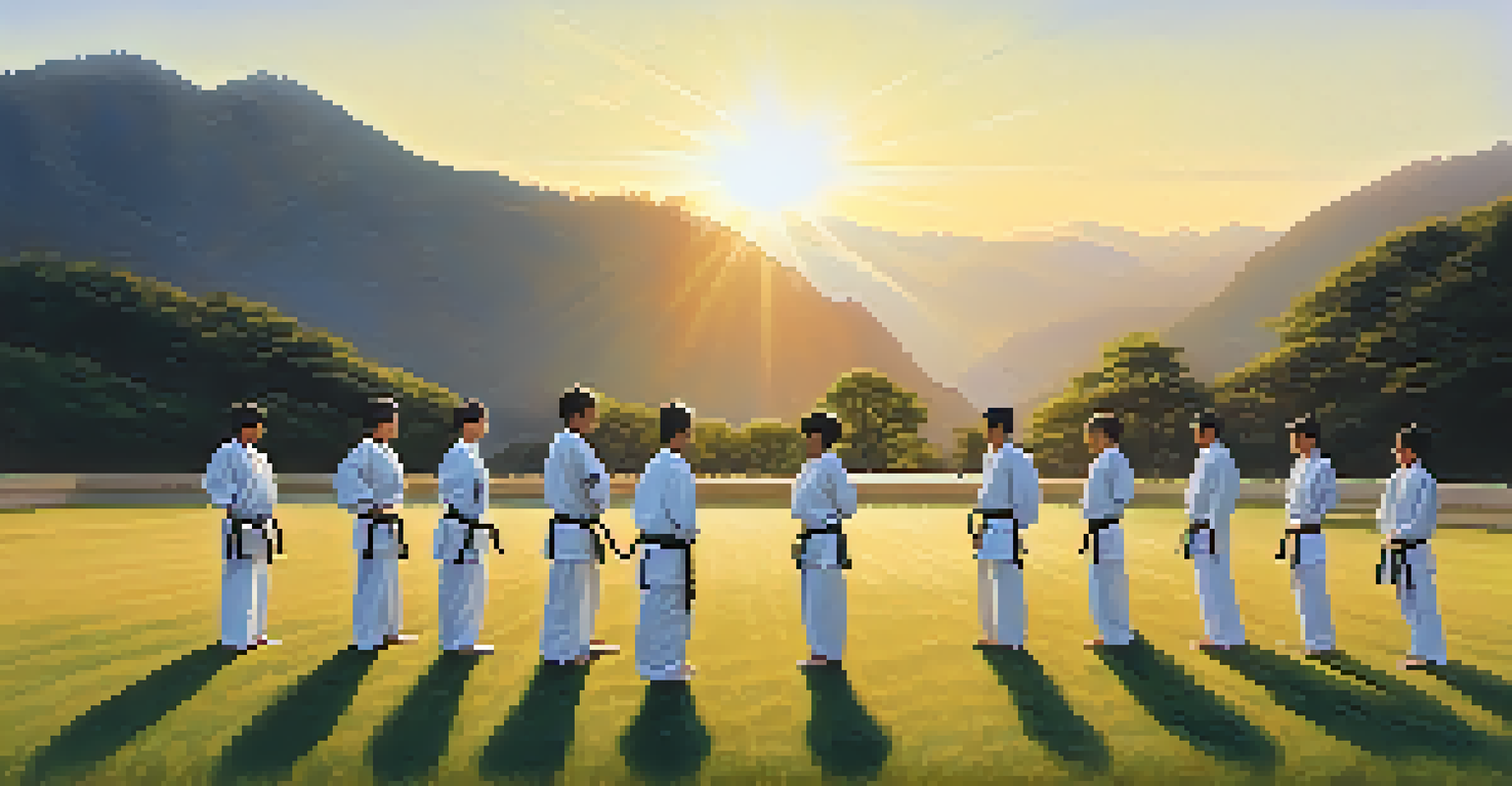Discipline in Martial Arts: A Pathway to Leadership Skills

Understanding Discipline in Martial Arts
Discipline in martial arts is more than just following rules; it's a commitment to personal growth and mastery. Practitioners learn that discipline involves consistency, focus, and dedication to their training. This structured approach not only hones physical skills but also cultivates mental strength, essential for any leader.
Discipline is the bridge between goals and accomplishment.
In martial arts, discipline is often enforced through routines and rituals, such as bowing before entering the dojo or practicing specific techniques repeatedly. These practices instill a sense of respect for the art, the instructor, and fellow students. By engaging in these rituals, students develop a deeper understanding of accountability and responsibility.
As students advance in their training, they begin to realize that discipline extends beyond the dojo. The skills and habits they cultivate can be applied to various aspects of life, from academics to career pursuits. This foundation is crucial for developing effective leadership qualities, as disciplined individuals are often seen as reliable and trustworthy.
Building Focus Through Training
Focus is a cornerstone of discipline, and martial arts training emphasizes this principle from the very beginning. Students must concentrate on their movements, techniques, and the nuances of their opponents, fostering a heightened sense of awareness. This skill is invaluable in leadership, where the ability to maintain focus can significantly impact decision-making.

During training sessions, martial artists learn to block out distractions and stay present in the moment. This practice not only enhances their performance but also teaches them to manage stress and maintain composure under pressure. Leaders who can keep their focus amid chaos inspire confidence in their teams.
Discipline Fuels Personal Growth
Martial arts discipline cultivates consistency and focus, essential for both training and effective leadership.
Moreover, the ability to concentrate on goals is essential for both martial artists and leaders. Setting clear objectives, whether it’s mastering a new technique or leading a project, requires unwavering focus. This shared journey of goal-setting fosters a mindset that encourages perseverance and determination.
The Role of Respect and Humility
Respect and humility are fundamental principles in martial arts that shape both practitioners and future leaders. In the dojo, students learn to respect their instructors, peers, and the art itself, cultivating a culture of mutual appreciation. This foundational respect translates into the workplace, where leaders who value their team members foster collaboration and trust.
The ultimate aim of the martial arts is not having to use them.
Humility is equally important, as martial artists are constantly reminded that there is always more to learn. Accepting feedback and recognizing one’s limitations are essential traits of a strong leader. By embracing humility, leaders create an environment where team members feel valued and encouraged to contribute their ideas.
Through the practice of respect and humility, martial artists develop emotional intelligence—an essential quality for effective leadership. Understanding and appreciating the perspectives of others enhances relationships and promotes a positive, productive atmosphere in any setting.
Resilience: Overcoming Challenges
Resilience is a vital characteristic developed through martial arts training. During their journey, practitioners face numerous challenges—be it mastering a difficult technique or overcoming personal fears. Each obstacle teaches them the importance of perseverance and the ability to rise after a fall, qualities that are crucial for effective leadership.
Leaders often encounter setbacks, whether in projects or team dynamics. The resilience cultivated in martial arts prepares individuals to face adversity with a positive mindset. This ability to bounce back not only enhances personal growth but also inspires others to adopt a similar approach in challenging situations.
Resilience Builds Strong Leaders
The challenges faced in martial arts teach resilience and a growth mindset, qualities crucial for overcoming leadership obstacles.
Moreover, the process of facing and overcoming challenges fosters a growth mindset. Martial artists learn that failure is a stepping stone to success, a perspective that leaders can benefit from significantly. By viewing setbacks as opportunities for learning, leaders can encourage their teams to innovate and strive for improvement.
Effective Communication Skills
Effective communication is key in martial arts, where clear instructions and feedback are paramount. Practitioners learn to listen attentively to their instructors and communicate their needs and concerns. This exchange fosters an environment of openness and trust, crucial for any leader aiming to motivate and guide their team.
In addition to verbal communication, martial arts also emphasizes non-verbal cues, such as body language and eye contact. Understanding these subtle signals can greatly enhance a leader's ability to connect with others. Leaders who are adept at reading and responding to non-verbal communication can foster stronger relationships and improve team dynamics.
As martial artists progress, they often take on leadership roles within their classes, teaching and guiding newer students. This experience hones their communication skills, as they must convey complex techniques in an understandable way. The ability to articulate thoughts clearly and effectively is an invaluable asset in any leadership position.
Teamwork and Collaboration in Martial Arts
While martial arts often emphasizes individual discipline, it also highlights the importance of teamwork. Many training sessions involve partner drills and sparring, where students must rely on one another to improve their skills. This collaborative environment teaches the value of working together towards a common goal, a key aspect of effective leadership.
In martial arts, students learn to support and uplift each other, fostering a sense of community. Leaders who encourage teamwork create a positive culture where team members feel empowered to share ideas and collaborate. This spirit of collaboration can lead to increased innovation and improved results.
Effective Communication is Key
Martial arts training enhances both verbal and non-verbal communication skills, vital for leaders to connect and inspire their teams.
Moreover, the camaraderie formed in martial arts classes often extends beyond the dojo. Building strong relationships with fellow practitioners can lead to lifelong friendships and networks. Leaders who understand the importance of fostering connections can create a cohesive team that works harmoniously toward shared objectives.
Setting Goals and Achieving Success
Goal-setting is an integral part of martial arts training, where practitioners strive for new belts, skills, and personal achievements. This focus on objectives helps students develop a clear vision of what they want to accomplish. For leaders, setting goals provides direction and motivates teams to work together towards a shared vision.
Throughout their journey, martial artists set both short-term and long-term goals, learning to celebrate their progress along the way. This practice encourages a sense of accomplishment and reinforces the importance of perseverance. Leaders who recognize and celebrate milestones foster a positive atmosphere that boosts morale and productivity.

Additionally, the process of goal achievement in martial arts teaches adaptability. Students often encounter unexpected challenges that require them to adjust their strategies. This flexibility is essential for leaders who must navigate changing circumstances and guide their teams toward success.